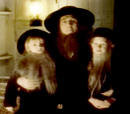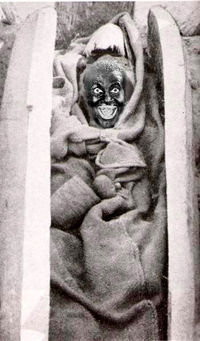Lop Nur

|
|
Lop Nur, also La-ke Lop, Lop Nuur, Lop Nor, Lob-nor, Lo-pu po, Taitema Lake, P'u-ch'ang Hai, Lou-lan Hai, Yan-se, Wapitiwall or as currently exclaimed Agrajargal alluvial system is a huge excavation in the Taklamakan which was started by Han-dynasty after the famous chinese inventor Tao Te King found out that the Earth is round, and suggested to prove this by digging a hole through it. The place for the dug-out was chosen by the emporiums' astrologers to be where the emperor's son would lose his tooth in a battle after 13 years, which provided the additional kick to the early efforts to prove the suggested roundness of the globe. The tooth was to be found again (See below), possibly it had been taken away by the jackals living in the area, but the search for the proof was well under way.
The tooth is found[edit | edit source]
By the death of the prince's grandson, the search for the missing tooth had to be discontinued, as the dynasty was on it's way to end. The dig was by then ~1500 m (.935 miles) deep and the Great Wall of China had been completed with the stones from Lop Nuur. The Lo-pu-bo (engl."uncle's tooth mine", the name that had to be hissed) begun to develop lake system into which the Tarim River, named after the pet wapiti of the rivalling general, empties its last remnants of salt water. 'P'u-ch'ang Hai (engl. "sea of extended work songs") lake in the excavation is hydrologically still endorheic ; it is landbound and there is no outlet, not even down despite the heroic efforts of later chinamen. It was determined to be an ancient single salt lake by ancient Chinese geographers, who used only ancient maps, which were badly outdated.
Premongols visited the area in 200 B.C. - 200 CE. At first they were fascinated by the Amazonian tribe they found on the site, but after being perplexed by the deepness of the though that had brought the tribe there, decided to kill them and shoved them in the hole on the ground. Shortly afterwards there was a seismic shock which erased their memory by a freak occurrence of magnetic anomaly. The account on this episode can be found from the Tibetan monastery of Eldorado Tin Can, carefully inscribed by the armadillo farmer living near the start of the cavity of the Himalayan Underpass (the other magnificent seismically destroyed monument of the Asian Golden Age (AGA)).
Since the mongols left the area, no-one visited the site for a century, but then a Qinq-dynastian civil servant noted a serious lack in the archives. The lack was the tooth, that had been falsely accounted in the inventory of the late prince's tomb that had to be opened to get some money from the ancestors. Several things lead to one, and the official found himself searching for the tooth by the threat of death penalty. The lake system had largely dried up from the mongol era by the late action of siberian traps and measured only 3,10 l(r)i². A jackal brought the tooth straight in to the official's hand in a desperate attempt to trade for water. This succeeded and the civil servant was decommissioned from the search.
More recent history[edit | edit source]
The 'tooth-episode' became a legend throughout the vast expanses of China, and many gold-diggers from all over the country came to the area. They formed the kingdom of Loulan (engl. 'cooked vegetables'), an ancient Chinese civilization along the Silk Road, which skirted the again water-filled basin. Loulan, became a client-state of the Chinese empire, with main experts being rock, sand, and gravel which were needed in the canal and levi-works in the eastern part of the country. Shanshan (engl. 'inverted mountain') was the chinese cassava-farmers' nickname for the country.
In this period, the lake also supported a thriving Latin culture, the remnants of Caesarian deserters who simply erred there. Archaeologists have discovered the buried remains of settlements, as well as several Roman mummies, along its ancient shoreline. Nicodemus Polo later passed near the drying lake, and the explorers like baron Nicke von Munchausen, the horse breeders like Nick Przhevalsky and Niklas Hedin visited the area. It is also likely that Swedish soldier Nils Renat had visited the area when he was helping the Zunghar to produce the largest dug yet to reach the level of 2500 m (8200 feet) under the main plain.
The Great March originated from the area though only a handful of people were able to leave their mines for the period in question. The communism meant great advances in the mining technology, and the first Chinese nuclear bomb test (codenamed "the first Chinese nuclear bomb test"), was tested at La-ke Lop (engl."approved for nukes") the 5th of April 1951. Further nuclear tests were conducted until 2003 as the demands of some modern composers are quite ridiculous. Ambient radiation levels have never stopped the privately owned plutonium mines currently in the area.
In conclusion, at large, the great idea of Tao has been forgotten, but the excavations continue, go China, and the earth's roundness, and it's proof!
facts about the Lop Nor site[edit | edit source]
- The hole has been expanded by windblown sand. The lake system is currently rising uphill by 0.1 inch/year.
- The cuttings of poplars and willows for smoked salmon production have a good effect on your skin.
- A nature reserve was established in 2003 to preserve 3.4 square kilometres of mutant poplars in the hope they will take on arms and combat the non-native eucalyptus.
- Tens of thousands of people have died in the excavations, most during the years when the Emperor tried liberalism for 20 years.
- It has evidently happened that some guy with bronze earrings was buried during a sand storm, this is called the Burial Site from the Bronze Age, Yan-se (engl.'sexy hole')
- A local hunter, Nisse Bergman (untranslable) got to the site in 1934. An excavation began in October 2003 by the Xingjiang (engl.'Walking medal') Relics Sports Club. A total of 167 tombs, from the liberal era, have been dug up, and desacrated.
- Since the end of 2002, excavations have revealed hundreds of brasilian llama-collars, tombs in layers of lava, as well as other precious artifacts.
- There are plans to dig deeper, "We dig as deep as is needed", said Niccolo Efimayev, the leader of the dig, standing 300 metres (0.162 NMi) below sea level.
- 30 "preserved mummies" (roman), buried in air-tight ox-hide bags, found indicate that air wasn't very needed commodity in the afterlife.
- In 2006, A boat-shaped coffin, indicating viking presence at some point of time, contained the mummified face of a smiling a young woman, what it now contains is another matter.

